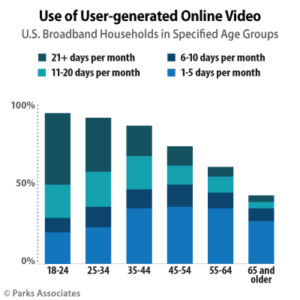Parks Associates today announced new OTT research showing nearly 35% of U.S. broadband households watch user-generated video online, on sites such as YouTube, Vimeo, and Dailymotion, more than ten days per month. Three-fourths of U.S. broadband households access this content at least once per month.
The research comes from one of three recently released research deliverables by Parks Associates that examine consumer demand for personalized services, entertainment and app strategies, and the impact of OTT and user-generated content on video production and distribution.
“Today’s home entertainment is all about personalization. Consumers now expect video, music, and gaming experiences to adapt to their needs, including anywhere, anytime, and any device access. Successful services are extending personalization into all aspects of the service experience and features,” said Brett Sappington, Senior Director of Research, Parks Associates. “Competition for customers and revenues will become even more intense in the future. New personalization technologies are driving simplified authentication, increased consumption, greater viewer engagement, and enhanced revenue generation.”
According to Parks Associates’ IoT research:
- Men watch user-generated online video more frequently than women, with men watching 11 days per month compared to less than nine days for women.
- Among viewers of user-generated online video, 22% indicate they are very likely to use an ad blocker to circumvent online video advertising.
- While virtually all U.S. broadband households are active online and visit sites with online advertising, only 17% believe that their online activity is tracked for marketing purposes.
The Parks Associates report Disruption in Video Sourcing and Production also examines the emergence of live streaming through apps like Facebook Live and Periscope and analyzes its impact on the OTT video space.
“Live streaming via mobile apps is in its early days—only 11% of U.S. broadband consumers indicate they have live streamed video using a live streaming app, while 13% of consumers have watched live streamed video on a mobile app,” said Glenn Hower, Senior Analyst, Parks Associates. “However, this developing market has already had its first big casualty, as Meerkat, which brought live streaming apps to the consumer market in 2015, exited this space following the success of Twitter’s Periscope and Facebook Live and YouTube’s announcement of its upcoming live mobile streaming technology. Meerkat’s demise came in part because of the app’s lack of primary social media interaction for creators, which underscores the importance of built-in personalization and interactive capabilities in this new media world.”

